Table of contents
- MotoGP engine electronics How does it actually work?
- Motor control uses 5000 parameters
- New software for 2016 a step backwards?
- “That could cause trouble”
- The machine becomes inaccessible
- “With 5000 parameters, it’s easy to go wrong”
- What does this software actually do?
- “It’s kind of like listening to the radio”
- Interview with Stefan Bradl
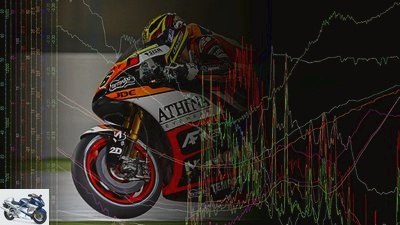
2snap
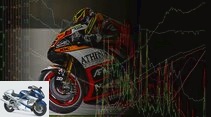
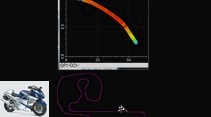
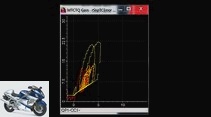
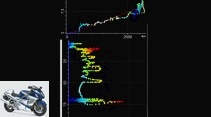
13th pictures
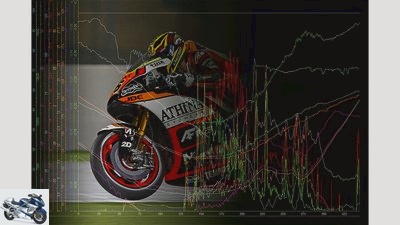
2snap / 2D
1/13
Around 10,000 numbers control the function of a MotoGP engine. The seemingly confusing diagrams of the engine electronics show how well they do it.
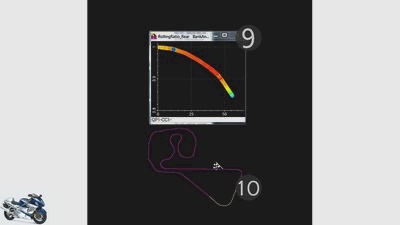
2D
2/13
⑨ Load on the tire flank due to slip: too little with blue, okay with green and extremely with red. The inclined position is displayed on the horizontal axis.
⑩ Route sketch of the Sachsenring. All representations on this screen relate to the curve marked in yellow.
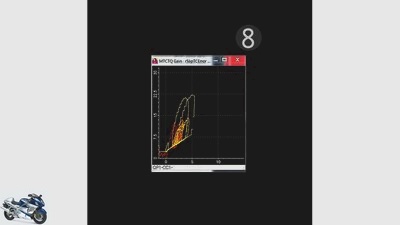
2D
3/13
⑧ Detection of the proportional / integral / differential component of the slip control.
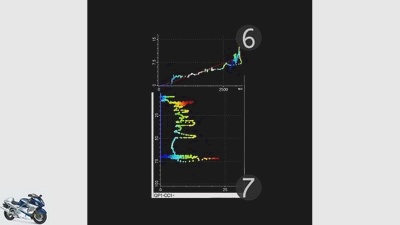
2D
4/13
⑥ Rear wheel slip and traction on the rear wheel.
⑦ Strength of traction control: Red is too much.
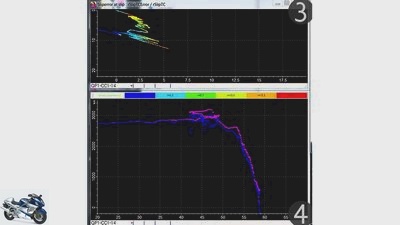
2D
5/13
③ Additional slip to the expected slip.
④ Torque: The curve in pink shows how much torque could be delivered at the moment, while the curve in blue shows how much torque is actually delivered.
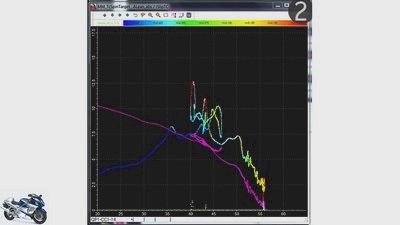
2D
6/13
② Slip on the rear wheel in an inclined position: The colors provide information on how strongly the traction control intervenes – mostly where it turns red. The inclination is displayed on the horizontal axis.

2D
7/13
① An overview of the traction control function – focused on the penultimate bend of the Sachsenring.
⑤ Overview of the most recently driven laps with lap times.

2D
8/13
The main screen of the traction control is next to the one for the wheelie control, the engine braking effect and the driver comparison one of the most important for the analysis. Most of what can be seen here says something only to professionals. Nevertheless, some information (more detailed in the following pictures): ① Function of the traction control ② Slip on the rear wheel ③ Additional slip to the expected slip. ④ Torque ⑤ Overview of lap times.
⑥ Rear wheel slip ⑦ Strength of traction control ⑧ Detection of slip control ⑨ Load caused by slip ⑩ Sketch of the Sachsenring circuit. All representations on this screen relate to the curve marked in yellow.
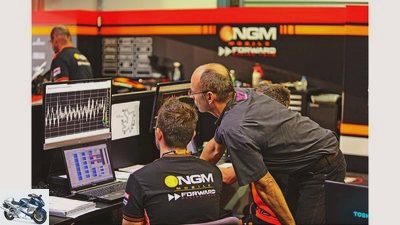
2snap
9/13
Thanks to the powerful analysis software, MotoGP electronics technicians can determine in detail how their motorcycle is behaving on the slopes.
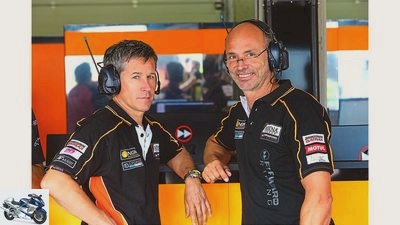
2snap
10/13
… his team is already busy reading out and processing the recorded data. Tex Geissler (left) and Dirk Debus have to handle data correctly and creatively.
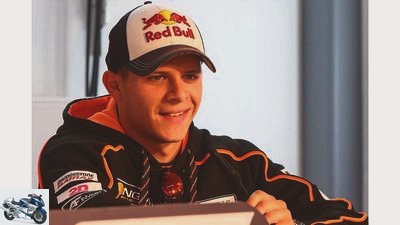
2snap
11/13
And while a driver like Stefan Bradl devotes himself to journalists’ questions, …
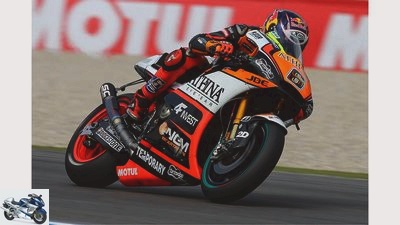
2snap
12/13
MotoGP electronics first need a lot of imagination. You need to be able to imagine how the digital substructure you put together affects the function of a MotoGP racer. The possibilities are endless.
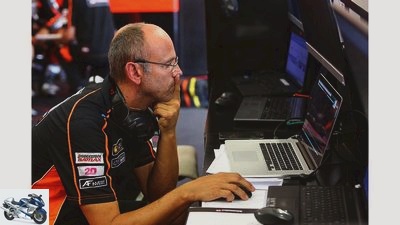
2D
13/13
Evil tongues claim that the author of these captions was sitting in front of his PC at this very moment. But that’s a lie, because I need both hands to type.
counselor
technology & future
MotoGP engine electronics
MotoGP engine electronics
How does it actually work?
Around 10,000 numbers control the function of a MotoGP engine. The seemingly confusing diagrams of the engine electronics show how well they do it. MotoGP electronics technicians therefore need a lot of imagination. You need to be able to imagine how the digital substructure you put together affects the function of a MotoGP racer. The possibilities are endless.
Andreas Schulz
07/01/2016
Stefan Bradl turns into the pit lane of the Circuit de Catalunya northwest of Barcelona. When he arrives at his team, a mechanic takes the motorcycle from him and pushes it backwards into the garage. The tire warmers are pulled up in a flash. So fast that the Bridgestone technician has to open it again to measure the temperature of the rubbers. An inconspicuous cable is plugged into the cockpit before up to four mechanics get to work briefly on the motorcycle – and, for example, clean the fairing windshield. After six minutes, Bradl is back on the slopes with his second machine.
Buy complete article
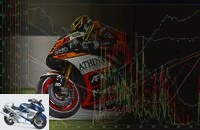
MotoGP engine electronics
How does it actually work?
6 pages) as PDF
€ 2.00
Buy now
The scene took place in June 2015 on Saturday morning during the third free practice session before the Catalonia Grand Prix, when Stefan Bradl was still on the road for the forward team on a Yamaha according to the Open regulations. If he hadn’t changed the bike and instead rode on with the one he’d just pitted, it might still have struck him as completely alien. Because the moment that cable was plugged in, the Yamaha became part of his team’s computer network, and its control electronics became a network device such as a printer or one of the Forward technicians’ workstations. They immediately downloaded the recordings from the data recording system and would have been able to completely reprogram the engine management system of the four-cylinder just as quickly.
Motor control uses 5000 parameters
During his short stop, Bradl had only exchanged a few words with his crew boss Sergio Verbena, the Bridgestone tire technician responsible and, most recently, with Dirk Debus. Debus is the man who founded the company 2D Data-Recording with his partner Rainer Diebold in 1993 in the Karlsruhe suburb of Durlach. 2D has developed the software that makes the reasonably comfortable handling of the mass of data, which on the one hand generates the data recording and on the other hand is necessary to control the actions of the engine control, possible in the first place.
IT support is sorely needed at this point. So that the engine control can do its work the way the driver and technician want it, it uses around 5000 parameters that are uploaded to it – for each set-up variant, of course. “And some parameters don’t just consist of a single value, but are based on an extensive table. Therefore, around 10,000 numbers are changed every time something is modified, ”says Dirk Debus.
New software for 2016 a step backwards?
The fact that so many values have to be changed is because Stefan Bradl, Debus and his team had to live with a special handicap. Until the end of 2014, Bradl had been spoiled for two years as a Honda factory driver in the LCR team with the highly developed Honda software for engine control. The fact that the Honda racing department HRC has hardly any limits financially or in terms of personnel is actually noticeable for the driver in the end. When Honda dropped Bradl at the end of 2014 because his results did not meet the expectations of the Japanese, he decided to switch to the Forward Yamaha team and thus to a third-class motorcycle in the Open category, for which the use of the Italian manufacturer’s engine control software Magneti Marelli was mandatory. Magneti Marelli was selected by MotoGP marketer Dorna as the supplier for the standard control system, which must be used by everyone – including the factory teams – from 2016.
In the first official tests of the system in late 2015, it did not make a good impression on the MotoGP stars. Valentino Rossi and Dani Pedrosa even noted a technological step backwards of five or more years.
Bradl and Debus, however, were already struggling with an even less mature version of this software in mid-2015. “The Magneti Marelli motor control only understands the huge data tables,” explains Debus, “Magneti Marelli does not have software that simplifies handling.” Therefore, the individual values in the tables had to be laboriously adjusted by hand.
“That could cause trouble”
Why the huge effort? Because it works, because everyone does it and because the rather clammy private teams don’t want to miss out on a possible advantage. Just one example: Data recording allows you to look at all conceivable parameters of the motorcycle in detail at every point on a racetrack. “When Stefan reports that he got along well on turn seven on his first lap, but slipped on the second lap, I can see if there were any differences in a table or other reasons for the slide that could be attributed to the account of the driver go. I know Stefan doesn’t like that. But he accepts it. “
Should Bradl have the feeling that something is wrong with the mixture at a certain point in a certain curve, he can have his engine man change it. With the help of the analysis software, he determines in which gear, with which throttle position and with how much speed Bradl was driving at the time in question. Then new tables are created for each of the four cylinders of the engine, which ensure that a suitable mixture is always blown into the combustion chambers with this combination of throttle position, gear and speed. Incidentally, the exact location of the motorcycle at the relevant moment is not determined by GPS – this is forbidden in the MotoGP World Championship – but via the distance covered. “The engineers in the works team have even come up with algorithms that can be used to take into account when a driver chooses a different line through the curve,” reveals Dirk Debus. He doesn’t say exactly how they work: “That could cause trouble.”
The machine becomes inaccessible
Since the electronics can only orient itself to the route traveled, they have to trust that the driver does not deviate from the intended route. If he does so, for example because he brakes himself and returns to the route via a shortcut or a detour, the commands from the engine control no longer match the route. The machine becomes inaccessible, if not dangerous.
With all the computer technology – motorcycle racing is still not possible without people. In Barcelona, eight people were working for Stefan Bradl on the Forward team. Sergio Verbena, his crew boss and first point of contact, the four mechanics who work directly on the motorcycle, the two Italians Alessandro Castagnetti and Luca Faso in the electronics department and the German manfed “Tex” Geissler. The Italian experts worked for Bradl as well as for his teammate Loris Baz. It is Castagnetti’s job to monitor the expressions of life in the engines. Is the engine running too rich or too lean? With the current fuel consumption, would the motorcycle come a race distance? If the oil pressure is okay everywhere, the fuel pump is working properly, a sensor somewhere gives up its ghost or signs appear that the engine is slowly breaking down?
“With 5000 parameters, it’s easy to go wrong”
Should Castagnetti decide that a leaner engine setting is necessary to make ends meet, it is Luca Faso’s turn. He is the man for the strategies and has to think about how he can cope with the emaciated mixture. Is it necessary to adjust the traction control because the engine is delivering less power overall? Has Stefan Bradl reported that the traction control works well at the corner apex, but regulates too much when accelerating? In which bend was that, in which gear did Stefan drive, how many degrees did he lean and what measures would help? As soon as Faso has an idea, he translates it into the columns of numbers for the motor control.
They then land on Tex Geissler’s screen. The former German motorcycle world championship rider, who celebrated his best result as third at the 125 cc Nurburgring GP 1997, has the most direct contact with the motorcycle. He is responsible for ensuring that the tables supplied are correct and that they have been properly transferred to the motorcycle electronics. That the motorcycle with the chassis set-up for rain also includes the engine mappings for rain. That Stefan Bradl can also use the switch on the handlebar to call up the planned default settings while on the move. “With 5000 parameters it is very easy to get something wrong,” says Dirk Debus. That is why Geissler must first and foremost be reliable, tidy and hard-working. Motorsport background is important, because Geissler should not only understand what the tables do, but also know what that means for his driver and how he can deal with it. “For Lucas’s strategy post you need a qualified engineer from the fields of mechanical engineering and electrical engineering,” explains Dirk Debus, “and for Allesandro’s engine management job you need a good technician with computer experience.”
What does this software actually do?
Debus himself is not on the Forward team’s payroll, although he is included in all electronics technicians’ deliberations. “When I take part in the races, it’s also a practical test of our software and development work for 2D,” says Debus. “It’s important for me to get a feel for how the technicians work on a GP weekend. How much they can accomplish in these three days, what conditions they have, what I can expect of them from the software side. ”These experiences give rise to ideas for new software functions that make work easier for the teams.
What does this software actually do? It’s called “WinARace” – “Win a Race” and is designed to help. It translates the digital information, which is supplied by the countless sensors on such a MotoGP motorcycle as numerical values via data recording, into an analog, graphic representation and thus makes the facts much easier to grasp. Ideally, it also frees the technician from the tiresome task of manually entering the desired values for programming the motor control into one of the large tables or having to change them there. Instead, he can draw the desired course of the values with the mouse as a curve, the software calculates the associated values from the analog representation and automatically writes them into the table. “We are already so far with the mixture,” confirms Dirk Debus, “we load the lambda values recorded during training into our software, tell it which values we want and then have the adapted tables generated directly.” The ones measured in the exhaust gas Lambda values provide information about how lean or rich the engine is and how the amount of fuel injected may have to be changed in order to achieve the desired result.
“It’s kind of like listening to the radio”
This example also illustrates only a fraction of the possibilities offered by the software package developed by Dirk Debus and Rainer Diebold – just the documentation of the data analysis module (software and documentation download at www.2d-datarecording.com) comprises almost 100 pages. No wonder, because behind this there are more than 20 years of experience, during which Debus also competed in motorcycle races. The 2D solution is used by the Yamaha MotoGP works team, by KTM in the Moto3 World Championship and in Formula 1; in the Moto2 World Championship, the company, which has meanwhile grown to 30 employees, is the exclusive supplier for the data recording systems. The 2D software is not even excessively expensive and costs 1500 euros in the standard version. For the kit version, which is mandatory in the Moto2 class, including the sensors also manufactured by 2D, there are individual arrangements depending on the requirements of the individual teams.
Fortunately, the rider in the saddle only has to think a few things about what has to happen in the background in order to have a motorcycle that is as perfectly tuned as possible. Stefan Bradl can see in a simplified representation how it affects his lap times when he tries different lines in the curves, brakes harder and accelerates or tries to get around the course as much as possible. The pilot cannot have a serious influence on the engine characteristics while driving. It’s similar to listening to the radio, says Dirk Debus. “We tune into the station for him, and depending on whether he likes the music, he can turn it up or down. The traction control in five levels, the wheelie control and the engine power in three levels each. But if he wants to listen to another station, he has to come to the pits. ”The colleagues from the technology department are sure to have something suitable in their repertoire.
Interview with Stefan Bradl
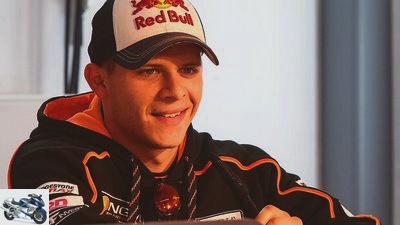
2snap
Stefan Bradl
? It is easy to understand that fast motorcycle racers have a great feeling for their motorcycle. Do they also have to be computer geeks in order to be able to use the possibilities of data recording and motor control in the best possible way?
! Of course, computers have become increasingly important in motorcycle racing lately. But I grew up with it, data recording already existed when I got in. It is important to know your way around. But a driver doesn’t have to be a freak. We don’t have to deal with it directly, we look at the data together with the engineers. It is important to have good people who prepare the data for me well. What I need to understand them, I have acquired “learning by doing”.
? In the last few months you have dealt with three different systems: that of the factory Honda, a preliminary stage of the Magneti Marelli system that will be mandatory for everyone from 2016 and, most recently, that of Aprilia. Are there differences to be felt??
! I don’t actually feel that while driving – with the exception of the Magneti Marelli system. The perfect controls work very smoothly and accurately when, for example, the motorcycle slips or the rear wheel starts to spin. They do not then abruptly reduce performance. At Honda I was very spoiled, so maybe I got a lot of problems with the Magneti Marelli electronics and complained so much. With the Aprilia solution, I feel much better again.
? The data recording enables the drivers to compare several laps of a training session and to see how a certain driving style affects the lap time in individual bends. Don’t you have to memorize a lot if you want to use this knowledge to drive an ideal lap?
! There is no such thing as an ideal round. There’s always an inch or a hundredth of a second somewhere that I could improve. Learning the hints from the data recording by heart doesn’t help either. It takes a lot of intuition and feeling. When I get to a racetrack, I first do a few laps, not at the limit, but fast. Of course, nothing has been perfectly coordinated yet, so I am collecting information. I pass them on roughly at the pit stop, then the settings are gradually refined – that’s the approach. The electronics technicians can of course compare my statements with the recorded data. On the way to the pits, however, I have to be able to remember which corner it slips or where I have another problem…
? Theoretically, the engine control can also be completely changed during a short pit stop. Does it happen that after the stop you drive on with a motorcycle that has a completely different character than before?
! That wouldn’t make much sense. We tend to make small changes that are already noticeable but are more visible in the data records. We can’t just take care of the engine control, we also have to monitor the chassis setup and the tires. In addition: If a technician were to send me out on the track with the announcement: “The mapping can be a bit aggressive”, I would say: “Then try it out for yourself.” but only during test drives.
? You are required to have a lot of trust in the technology, but you fell in 2015 because a sensor broke, so the traction control failed and you received no warning. How does a driver deal with such experiences?
! I had two defects, one of which ended in a fall. I was really angry at that. Something like that shouldn’t happen, but it does happen that there is a defect or an error is brought in with a new mapping. This is what the run-off zones are for.
? You can simply give full throttle at the exit of a curve and the traction control then ensures that no more power arrives at the rear wheel than is good for a safe journey?
! Drive out of the bend and just give full throttle? I don’t know anyone who does that. We have so much performance that it takes a little respect. I still do it the same way as I did in my two-stroke times – gently pulling the gas out of the curve. The traction control regulates, but the more it regulates, the slower I drive.
There is nothing like a good feeling for the rear wheel in your wrist. The more I let the traction control do the more difficult it becomes with tire wear. I have to find the right combination between traction control and self-controlled sliding and spinning of the rear wheel.
? What does a typical conversation between driver and technician sound like during a pit stop?
! It’s like a question and answer game. Sometimes I have to say, “Guys, I’m sorry, I don’t feel any change.” The most important thing is to be honest in the situation as a driver.
Related articles
-
2snap Sports & scene Motorsport Report: MotoGP technology The technology in the MotoGP class Stefan Bradl on the bikes in the premier class Content of…
-
Flashing electronics tuning chip control unit
Bilski accesories Flashing electronics tuning chip control unit Electronics tuning, chip, control unit Flash, flash, flash! Content of Overwriting…
-
Yamaha 20th pictures KTM 1/20 HP knowledge technology part 17 – Electronic injection and engine control. Yamaha 2/20 HP knowledge technology part 17 -…
-
Technology: injection electronics
K counselor technology & future Technology: injection electronics Technology: injection electronics What’s humming there?? Content of When five-year-olds…
-
KTM Sports & scene Motorsport KTM extends MotoGP until 2026 KTM in MotoGP The oranges extend until 2026 The motorcycle manufacturer KTM has been…
-
Ducati’s strategy for the 2016 MotoGP season
Kirn 8th pictures 2snap 1/8 For two years the Ducati racing department has been working to catch up with the apparently superior Japanese motorcycle…
-
BMW R60-2 conversion: engine art for a museum
Fraser Evans 10 pictures Fraser Evans 1/10 Jay builds the Amadeus on behalf of an art museum for motorcycles. Fraser Evans 2/10 The core elements are the…
-
Eisele counselor workshop Buy the right engine oil Something smeared MOTORCYCLE Oil Primer: Buying the Right Motor Oil If you want to find the right…
-
Ducati’s new Desmosedici Stradale V4 engine
Kirn counselor technology & future Ducati’s new Desmosedici Stradale V4 engine Ducati’s new Desmosedici Stradale V4 engine Beginning of a new era Ducati…
-
Gold and Goose Sports & scene Casey Stoner – MotoGP star Portrait: Casey Stoner The dominator of the 2011 MotoGP season Content of A country egg at…